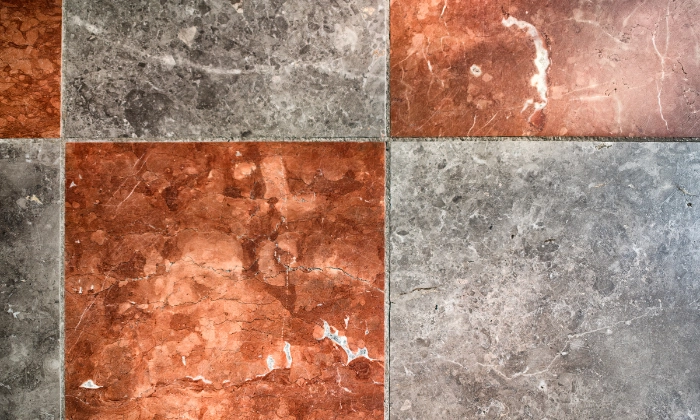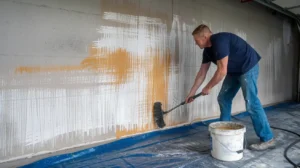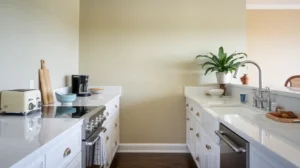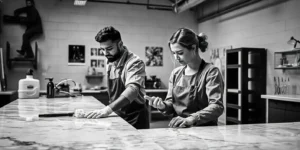How to Remove Paint from Concrete How to Remove Paint...
Read MoreDoes Marble Scratch Easily
Marble has long been cherished for its timeless elegance and natural beauty. However, many homeowners and enthusiasts often wonder. Does marble scratch easily? In this comprehensive blog post, brought to you by Stone Sealer & Restoration, we delve deep into the intricacies of marble’s scratch resistance.
We will provide valuable information on factors that contribute to marble’s susceptibility to scratches, tips for prevention, and how our services can help maintain your marble’s lustrous finish.owners and designers. Let’s explore the various aspects of marble’s scratch resistance.

The Composition of Marble
Calcite: The Key Component
At its core, marble is primarily composed of a mineral called calcite. This mineral is known for its characteristic veining and smooth texture, which contribute to marble’s unique aesthetic appeal.
Calcium Carbonate: The Building Block
Calcite is a form of calcium carbonate, a compound that plays a central role in the formation of marble. This compound not only gives marble its distinct appearance but also influences its susceptibility to scratches.
Factors Affecting Marble's Scratch Resistance
Marble, with its timeless allure, is renowned for its visual appeal. However, its susceptibility to scratches is a consideration that shouldn’t be overlooked.
Several factors contribute to how resistant marble is to scratches, which can help you make informed decisions when choosing this elegant stone for your surfaces.
Mineral Composition
The specific minerals present within the marble can significantly impact its scratch resistance. While calcite is the primary component, variations in the presence of other minerals can influence the hardness of the stone. Some impurities might make the marble softer, making it more prone to scratches.
Finishing Techniques
Different finishing techniques can alter the scratch resistance of marble. Marble polishing, for instance, has a smooth and reflective surface that enhances its visual appeal but also makes it more susceptible to scratches compared to other finishes like honed or leathered.
Usage and Traffic
The intended use of the marble is another crucial factor. High-traffic areas like kitchen countertops are more susceptible to scratches due to the frequent contact with utensils, cookware, and other objects. Decorative marble pieces in low-traffic areas might not face the same level of scratching.
Protective Measures
While marble’s susceptibility to scratches is influenced by its composition and use, certain preventive measures can minimize the risk. Using cutting boards when working in the kitchen, placing protective pads under objects, and following proper cleaning practices all contribute to maintaining the marble’s appearance.
Maintenance and Care
Regular maintenance plays a pivotal role in preserving the scratch resistance of marble. Cleaning with soft materials, using pH-balanced marble cleaners, and avoiding abrasive substances can all contribute to the longevity of the stone’s pristine appearance.
Expert Intervention
In cases where scratches have occurred, seeking professional restoration of the marble floor can be a viable solution. Expert technicians can assess the damage and employ specialized techniques to restore the marble’s surface, reducing the visibility of scratches.
Understanding Mohs Hardness Scale
To assess a material’s scratch resistance, we refer to the Mohs Hardness Scale, which rates minerals from 1 (softest) to 10 (hardest). Marble typically falls around 3 on this scale, while common culprits like quartz and sand (found in dust) rate higher, making them capable of scratching marble.
Common Misconceptions about Marble
Marble, with its innate elegance and timeless beauty, is a favored choice for interior design and architectural applications. However, there are several misconceptions surrounding the scratch resistance of this exquisite stone.
Let’s debunk these myths and gain a clearer understanding of how to care for and enjoy marble surfaces without unnecessary worry.
Misconception 1: Marble Is Scratch-Proof
One of the most common misunderstandings is that marble is entirely scratch-proof. While marble is undeniably stunning, its composition, primarily consisting of calcite, renders it susceptible to scratches, especially when exposed to abrasive materials or sharp objects.
Misconception 2: Only Heavy Objects Can Scratch Marble
It’s important to realize that even relatively lightweight items can cause scratches on marble surfaces. Abrasive particles brought in from shoes, dust, or other sources can create micro-scratches over time, dulling the surface’s shine.
Misconception 3: Sealing Eliminates the Need for Caution
While sealing marble surfaces does offer protection against stains and etching, it doesn’t make the stone immune to scratches. Sealing helps prevent substances from penetrating the surface, but it doesn’t alter the intrinsic softness of marble.
Misconception 4: All Marble Finishes Offer Equal Scratch Resistance
Different marble finishes impact scratch resistance differently. Polished marble, for instance, may showcase scratches more prominently due to its smooth, reflective surface. Matte or honed finishes, on the other hand, can sometimes mask scratches better.
Misconception 5: Scratches Can’t Be Fixed
Minor scratches on marble surfaces can often be mitigated through polishing. Professional restoration experts can assess the depth of scratches and employ suitable techniques to restore the surface’s appearance. However, prevention remains the best approach.
Misconception 6: Cleaning with Any Product Is Safe
Using harsh or acidic cleaners on marble surfaces is a misconception that can lead to damage. Acidic substances can react with the calcium carbonate in marble, causing marble etching and compromising its scratch resistance.
Misconception 7: Scratches Only Affect Appearance
While scratches certainly affect the visual appeal of marble, they can also impact its integrity over time. Deep scratches can harbor dirt and moisture, potentially leading to more severe damage if left untreated.
Preventive Measures to Minimize Scratches
- Use Cutting Boards: When working in the kitchen, always use cutting boards to protect your marble countertops from scratches caused by knives.
- Felt Pads: Place felt pads under objects placed on marble surfaces, such as vases or decorative items.
Proper Cleaning and Maintenance
Regular cleaning using a soft microfiber cloth and a pH-balanced marble cleaner is vital. Avoid abrasive cleaners that can deteriorate the surface and increase vulnerability to scratches.
DIY Solutions for Minor Scratches
Even with the best precautions, minor scratches can sometimes occur on your beloved marble surfaces. Fortunately, there are effective do-it-yourself DIY solutions you can try to minimize the appearance of these blemishes and restore the beauty of your marble.
Keep in mind that these methods are suitable for shallow scratches and may not work for deeper or more extensive damage.
Solution 1: Marble Polishing Powder
Marble polishing powder is a gentle abrasive compound designed to buff out surface imperfections, including minor scratches. Here’s how to use it:
Clean the Surface: Begin by cleaning the scratched area with a pH-balanced marble cleaner and a soft microfiber cloth. This ensures that no debris or dirt particles worsen the scratch during the process.
Prepare the Powder: Mix the marble polishing powder with water according to the manufacturer’s instructions to create a thick paste.
Apply and Buff: Using a soft cloth or a buffing pad, apply the paste to the scratched area. Gently rub the paste in circular motions, gradually increasing pressure. This will help the polishing powder break down the scratch and restore the surface’s shine.
Clean and Assess: After buffing, clean the area again to remove any residue. Assess the scratch’s visibility. If the scratch is still noticeable, you can repeat the process until you achieve the desired result.
Solution 2: Baking Soda Paste
Baking soda is a household staple that can also be used to address minor scratches on marble surfaces. Here’s how:
Create a Paste: Mix a small amount of baking soda with water to create a thick paste.
Apply Gently: Using a soft cloth, apply the baking soda paste to the scratched area. Gently rub in circular motions, being cautious not to apply excessive pressure.
Rinse and Evaluate: Once you’ve rubbed the paste, rinse the area thoroughly with water and dry it with a clean cloth. Assess whether the scratch’s appearance has improved.
Remember that both of these methods require a gentle touch and patience. It’s advisable to start with a small, inconspicuous area to test the effectiveness of the solution before applying it to more prominent scratches.
For deeper or extensive scratches, it’s best to consult a professional marble restoration specialist to ensure the proper care and maintenance of your valuable marble surfaces.
Professional Restoration and Repair
When faced with more significant scratches or damage on your cherished marble surfaces, seeking the expertise of professional restoration and repair specialists becomes essential.
These experts possess the knowledge, skills, and tools required to assess and address deeper scratches, ensuring your marble surfaces regain their original luster. Here’s what you can expect from professional restoration and marble scratch removal services:
Thorough Assessment
Professional technicians will thoroughly examine the extent of the scratches and damage. This assessment helps them determine the most suitable approach to restoration, taking into account factors such as the type of marble, the depth of scratches, and the overall condition of the surface.
Tailored Restoration Techniques
Based on their assessment, the technicians will employ tailored restoration techniques. These may include advanced polishing methods, honing, and re-finishing to carefully diminish the appearance of scratches while preserving the integrity of the marble.
Precision and Expertise
Professional restoration specialists have honed their skills through experience and training. They understand the nuances of different types of marble and the intricacies of the restoration process. This expertise ensures that the restoration is carried out with precision, minimizing any risk of further damage.
Quality Materials
Reputable restoration professionals use high-quality materials that are specifically designed for marble restoration. This includes specialized abrasives, polishes, and sealers that are proven to yield the best results without compromising the marble’s composition.
Consistency and Results
Professional restoration guarantees consistent and impressive results. Scratches that were once prominent can be significantly reduced or even made virtually invisible, restoring the marble’s original elegance.
Long-Term Benefits
Beyond addressing scratches, professional restoration also helps enhance the overall longevity of your marble surfaces. The techniques used not only improve aesthetics but also contribute to the marble’s durability and scratch resistance.
Guidance for Maintenance
After the restoration process, technicians often provide guidance on proper maintenance practices to prevent future damage. This might include advice on cleaning products, protective measures, and how to care for your marble surfaces to ensure they retain their restored beauty.
Peace of Mind
By entrusting your marble surfaces to professionals, you gain peace of mind knowing that your valuable investment is in capable hands. Professional restoration eliminates the uncertainty associated with DIY solutions and ensures that the outcome meets the highest standards.
Pros and Cons of Choosing Marble
Pros:
- Luxurious Aesthetic
- Unique Patterns
- Heat Resistance
Cons:
- Susceptibility to Scratches
- Maintenance Requirements
Conclusion
In the end, the question Does marble scratch easily? comes down to understanding its unique characteristics and taking the necessary precautions to preserve its beauty.
While marble adds an undeniable touch of elegance, it requires thoughtful care to withstand the test of time. By following the preventive measures, cleaning routines, and seeking professional help when needed, you can enjoy your marble surfaces for years to come.
Remember, maintaining marble requires a balance between cautious care and professional intervention. To ensure the longevity of your marble surfaces, contact Stone Sealer & Restoration experts for personalized solutions.
Frequently Asked Questions (FAQs)
Q1: Can I cut directly on marble countertops?
A: It’s advisable to use cutting boards to prevent scratches.
Q2: How often should I seal my marble surfaces?
A: Depending on usage, sealing every 6 to 12 months is recommended.
Q3: Can scratches on marble be completely repaired?
A: Minor scratches can often be diminished through polishing, but deep scratches might require professional intervention.
Q4: Are there alternatives to marble with better scratch resistance?
A: Yes, materials like granite and engineered quartz offer higher scratch resistance.
Q5: What’s the role of Stone Sealer & Restoration in marble care?
A: Stone Sealer & Restoration provides professional services to restore and maintain the beauty of marble surfaces. Call us today to ensure your marble’s longevity.
Our Services
Our Recent Post
Top 7 Popular Quartz Countertops Colors in 2024
Top 7 Popular Quartz Countertops Colors in 2024 Quartz countertops...
Read MoreHow to Clean a Granite Composite Sink | Simple Steps for a Spotless Finish
How to Clean a Granite Composite Sink | Simple Steps...
Read MoreMarble Countertop Restoration | Professional Repair and Polishing Services
Marble Countertop Restoration | Professional Repair and Polishing Services Marble...
Read More



